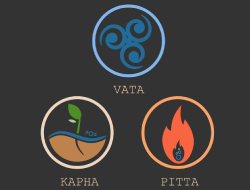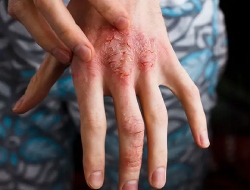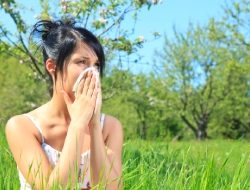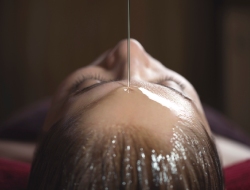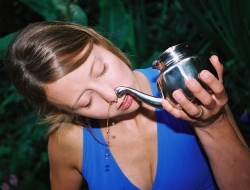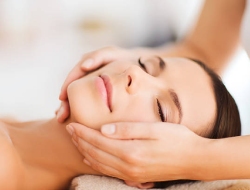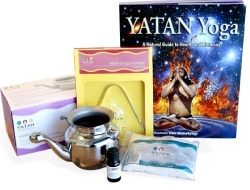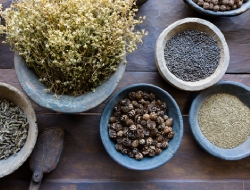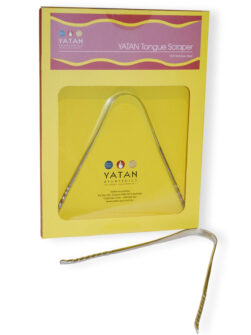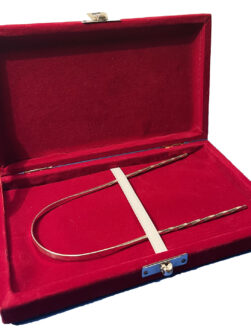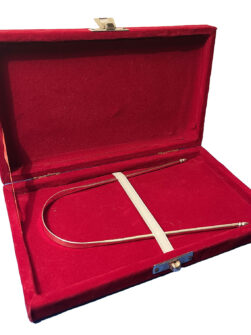Cleaning your tongue should be done first thing in the morning, before drinking or eating. This maximises removal of any ama (digestive toxins) from the tongue.
- Brush your teeth and floss, then rinse your mouth.
- Hold the tongue scraper gently in both hands. Open your mouth and place the curved part as far back on the tongue as is comfortable without gagging.
- Gently pull the scraper forward over the surface of the tongue to the tip of the tongue.
- Rinse any debris under running water and repeat the scraping action 4 or 5 times on the left, middle and right side of the tongue, rinsing the scraper each time.
- When finished, thoroughly rinse the tongue scraper under running water and hang to dry in your toothbrush holder.
- Rinse your mouth with water.
Watch our short video on how to use your tongue scraper:
Cleaning your Sterling Silver or Stainless Steel Tongue Scraper
Caution:
- Do not use if the tongue has ulcers, bleeding or other medical problems exist on the tongue
- When using, do not apply excessive pressure on the tongue
- Children should be supervised by an adult. Not recommended for children under 5
- For hygenic reasons, tongue scrapers should not be shared
What is Tongue Scraping or Tongue Cleaner?
Using a tongue scraper is a method of cleaning the tongue to remove any coating, mucous and other debris that may have accumulated overnight this in turn improves oral hygiene. This is most easily achieved using a well-designed tongue scraper or tongue cleaner, commonly made from stainless steel, silver or other metals like copper.
Why Do It? Do you know the reasons for bad breath, morning breath or a white/colored coating on your tongue?
While brushing and flossing remove bacteria from the teeth and gums, it is the forgotten bacteria living on our tongues that can be the reasons for bad breath and even interfere with our sense of taste. Nearly 50% of our oral bacteria live in the deep crevices of the tongue, and are a major source of bad breath (Halitosis). The bacteria release odorous volatile sulphur compounds as they thrive on the tongue. Daily tongue scraping helps to decrease the amount of plaque-causing bacteria that can lead to bad breath, gum disease, and tooth decay. The decomposing bacteria can also create inflammation in the mouth leading to tongue sores. As the coating provides a base for the microbes to grow on, removing the coating is vital to killing the bacteria that cause bad breath.
Dental research has found that using a tongue scraper is many times more effective at removing bacteria from the tongue than a toothbrush just like a Tongue Brush. Brushing the tongue will loosen and move any debris around, but is not an efficient or effective way of removing the deposits from your tongue. The sweeping action of a tongue scraper will collect the waste deposits in its U bend allowing them to be rinsed away under the tap.
An Ayurvedic tradition on Tongue Scraper…
Jihwa Prakshalana (tongue scraping) has been an important part of the Ayurvedic daily routine for maintaining oral health for thousands of years.
During sleep when the body is resting, the digestive system works to detoxify itself. These toxins, ama, are deposited on the surface of the tongue via the internal excretory channels, and are responsible for the coating usually seen on the tongue first thing in the morning. The coating may be yellow, white, black or bluish in colour.
By removing this coating using a tongue scraper, the tongue’s pores and taste buds open, allowing it to function efficiently. When our taste buds become blocked we are unable to recognise the taste of food, and the receptors in our tongue become unable to convey the right message to the brain, which confuses our sense of taste and desire for the right food for our constitutional type. False cravings may also be caused by these blockages and can be detrimental, depriving the body of specific necessary nutrients.
Scraping also avoids these toxins being reabsorbed by the body, as according to traditional Ayurvedic text The Charaka Samhita various types of digestive and respiratory problems can result from continued reabsorption of these waste products.
The dirt which is collected at the root of the tongue creates obstructions in respiration and produces a foul smell; hence one should scrape one’s tongue (from Caraka Samhita, Sutrasthana, V, 75.)
The tongue reveals many insights to your body’s internal health, and daily scraping helps improve digestion by activating saliva production and kindling agni, your digestive fire, for the day ahead.
A healthy tongue will look clean, and be pinkish in colour. With continued daily use you will find your overall oral health improving.

